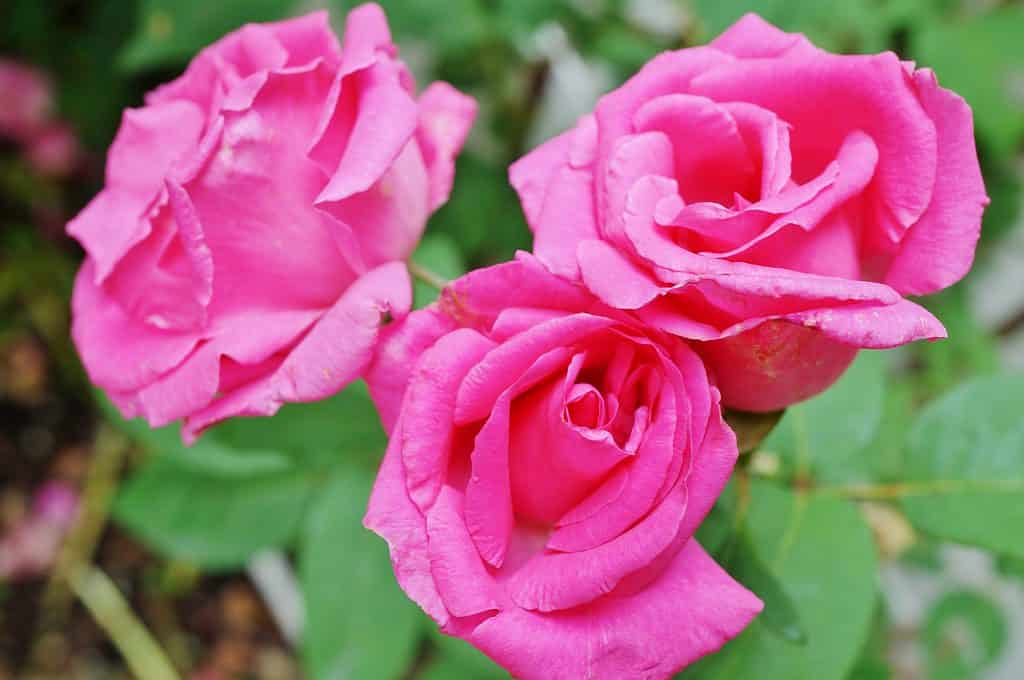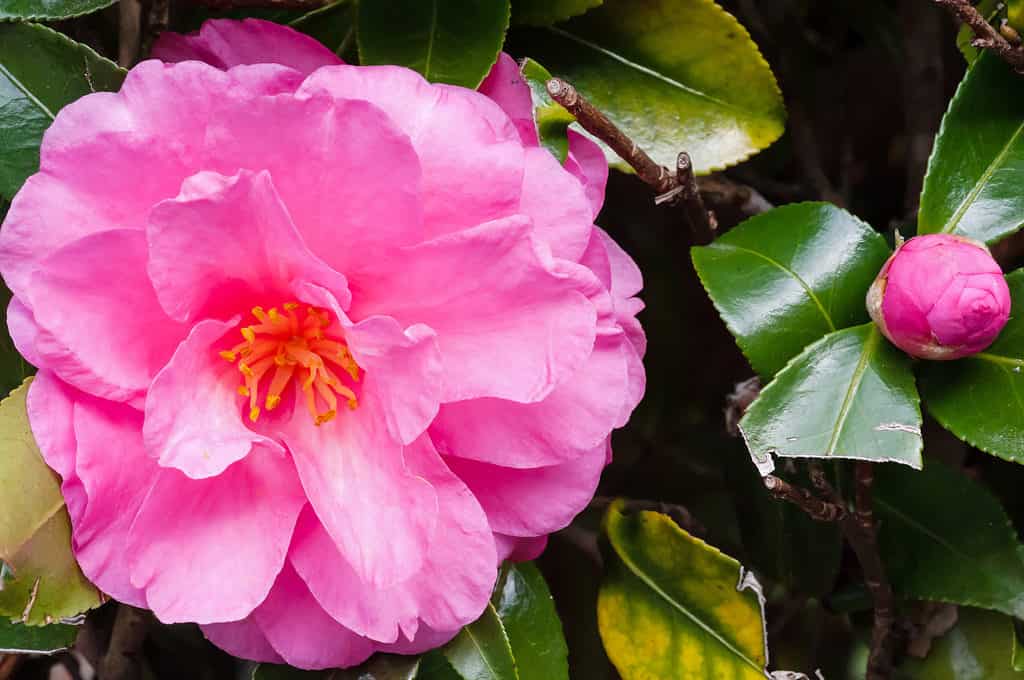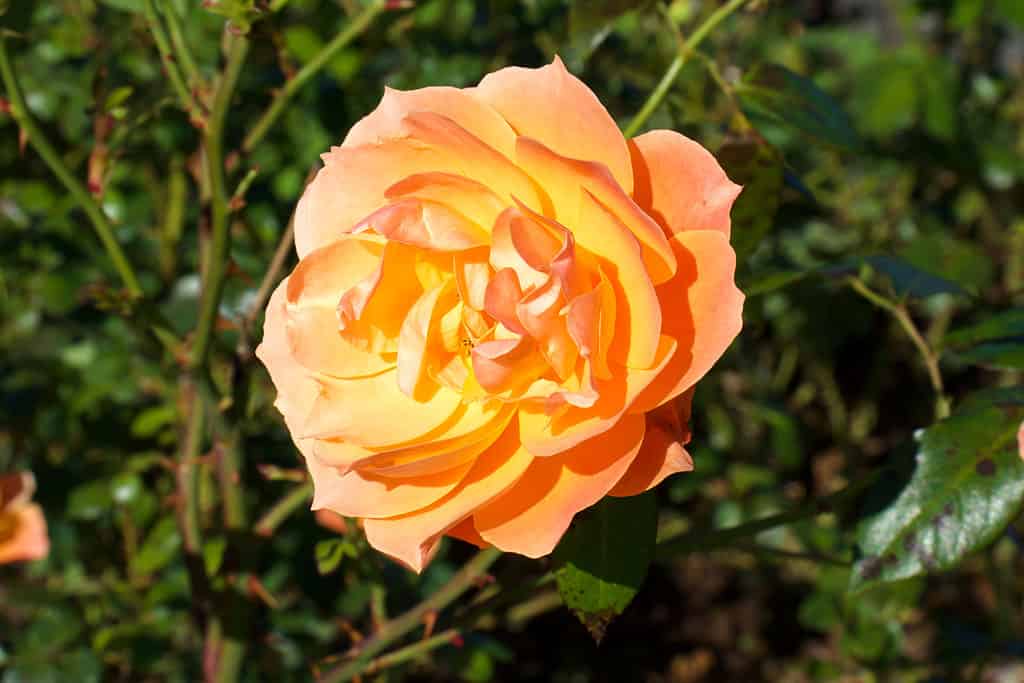In the heartland of Kentucky, where the thunderous roar of hooves marks The Run for the Roses, the iconic Kentucky Derby, another contest for the best is racing through the backyards of Kentucky: a race to grow the hardiest roses. Throughout the rolling hills, these resilient blossoms defy nature’s whims, blooming with grace and determination. Just as the thoroughbreds gallop toward victory, these unsung heroes of the garden thrive in the face of unpredictable weather and stubborn soil. Much like the spirited jockeys guiding their steeds, Kentucky’s green-thumbed gardeners know the importance of selecting breeds that can endure both scorching summer sun and biting winter winds. From old-fashioned heirloom roses to newer varieties, like the stunning Knock Outs, many roses fit the bill. So, saddle up, as we trot about, discovering the five hardiest roses to grow in Kentucky.
What is a Rose?
Roses are a type of flowering plant that belongs to the genus Rosa in the family Rosaceae. They are known for their beautiful and fragrant blossoms. Roses are native to various parts of the world and are widely cultivated for their aesthetic appeal. They are characterized by their thorny stems and compound leaves, typically with serrated edges. In addition, the flowers of a rose plant can vary in color, including shades of red, pink, white, yellow, and orange. They typically have multiple layers of petals arranged in a symmetrical pattern.
Roses have been cultivated by humans for thousands of years. They are often associated with love, beauty, and romance, making them a popular choice for gifts and decorations. Roses vary dramatically in size, fragrance, and also petal arrangement. Apart from their ornamental value, roses also have practical uses.
Extracts from rose petals are used in perfumes, cosmetics, and various other products. Some species of roses also produce edible fruits called rose hips. Rose hips are rich in vitamin C and are used in teas, jams, and also herbal remedies. Now, discover the five hardiest roses to grow in Kentucky.
1. Old-Fashioned Heirloom Roses
Where beauty and fragrance reign supreme, there exists a treasured class of blooms that carries the weight of history upon its delicate petals. Old-fashioned heirloom rose bushes are not mere flowers. They are living legacies, timeless treasures passed down through generations, preserving the charm and grace of a bygone era. Old-fashioned heirloom roses harken back to a time when the world moved at a slower pace.
These roses often date back a century or more. However, they boast a rich lineage and a captivating story that unfolds with each unfurling bud. One of the defining characteristics of these roses is their remarkable resilience. These shrubs have weathered the test of time, surviving in gardens with minimal care and attention. They possess an innate hardiness, adapting to different climates and soil conditions with ease. In addition, their sturdy canes and abundant foliage provide a framework for the lavish blooms. Blooms burst forth in a symphony of colors—soft pinks, velvety reds, creamy whites, and also vibrant yellows.
Intoxicating Scents
But it is not just their endurance that sets old-fashioned heirloom roses apart. It is also their enchanting fragrances that transport us to a bygone era. These roses perfume the air with intoxicating scents that evoke memories of secret gardens. The timeless beauty of old-fashioned heirloom roses lies in their exquisite flower forms. These roses, often single or semi-double, exude an understated elegance that captivates the eye and also inspires the soul.

Heirloom roses harken back to a time when the world moved at a slower pace.
©EQRoy/Shutterstock.com
Varieties of Heirloom Roses
Heirloom roses generally refer to varieties that have been cultivated for many years. These roses are known for their classic and nostalgic beauty, rich fragrances, and diverse colors. Some famous heirloom rose varieties include the Damask roses, Bourbon roses, Gallica roses, Moss roses, and also Alba roses. Specific heirloom varieties include:
- Rosa Madame Hardy is a beautiful Damask rose variety that dates back to 1832. It features large, pure white, double blooms with a strong fragrance. Madame Hardy is known for its hardiness, disease resistance, and elegant appearance.
- Rosa Reine des Violettes is also known as Queen of the Violets. This classic hybrid perpetual rose became introduced in 1860. It has large, fully double, deep purple blooms with a rich, intoxicating scent. This rose has old-fashioned charm and the ability to bloom repeatedly throughout the season.
- Rosa Gloire de Dijon is a beloved climber that was bred in France in 1853. It belongs to the Tea Rose group. This rose offers exquisite apricot-yellow flowers with a delightful fragrance. Gloire de Dijon is prized for its vigorous growth and disease resistance. It is a splendid choice for covering arches, trellises, and walls with its abundant blooms.
2. Landscape Roses
Landscape roses, also known as shrub roses, are a versatile and popular category of roses specifically bred and cultivated for their ability to enhance and beautify outdoor landscapes. These roses possess a combination of desirable traits that make them well-suited for various landscaping purposes.
Unlike traditional hybrid tea roses or floribundas, which often require meticulous pruning and regular maintenance, landscape roses are low-maintenance and resilient. They are bred to be disease-resistant, drought-tolerant, and adaptable to a range of soil types, making them ideal for creating colorful, thriving garden displays in a wide array of environments.
A key characteristic of landscape roses is their growth habit. They typically have a bushy and spreading form, with sturdy canes and dense foliage. This growth habit allows them to fill in garden spaces.
Landscape roses are prolific. They produce abundant clusters of flowers in various shades of pink, red, yellow, and white. While individual blooms may be smaller than those of hybrid tea roses, the sheer profusion of blossoms creates a vibrant and eye-catching display.
These roses often have a long blooming season, providing a sustained burst of color throughout spring, summer, and into fall. Due to their versatility and adaptability, landscape roses have a purpose in a variety of outdoor settings.

Unlike traditional hybrid tea roses or floribundas, which often require meticulous pruning and regular maintenance, landscape roses are also low-maintenance and resilient.
©
Landscape Varieties
Their ability to thrive in different conditions, coupled with their abundant and continuous blooming, make Landscape roses an excellent choice for those seeking to enhance their landscapes with vibrant and resilient floral displays. Rosa Sally Holmes is a beautiful landscape rose. It became introduced in 1976. It features clusters of fragrant, creamy white flowers that gradually fade to soft pink.
Admirers of this rose appreciate it for its disease resistance, tall and bushy growth habit, and ability to thrive in a wide range of climates. The Drift series of roses are compact, low-growing landscape roses that offer abundant blooms and excellent disease resistance. These roses do well for borders, groundcovers, and container gardening. The Drift series includes a range of colors, such as red, peach, coral, and also pink, providing options for various landscape designs.
3. Carpet Roses
Carpet roses, often referred to as groundcover roses, are a versatile and popular group of roses appreciated for their spreading growth habit, continuous blooming, and low-maintenance nature, making them a fantastic choice for various landscape applications. They typically have a semi-prostrate growth habit, with flexible canes which allow carpet roses to cascade over walls, slopes, or garden edges.
One of the standout features of carpet roses is their abundant and continuous blooming. They produce clusters of petite flowers in various colors, including shades of pink, red, white, and yellow. While individual blooms may be smaller than those of other rose varieties, the sheer profusion of flowers creates a dazzling display that lasts from spring until frost. Additionally, these roses can produce thousands of blooms in a single season.
Disease Resistant
Carpet roses are renowned for their hardiness and disease resistance. They will withstand a wide range of growing conditions and climates. These roses exhibit excellent resistance to common rose diseases, such as blackspot and powdery mildew, reducing the need for intensive spraying and making them easier to care for. Their hardy nature allows them to thrive in both hot and cold climates, and they can tolerate various soil types.
Carpet roses are low-maintenance plants. They require minimal pruning and are generally self-cleaning, meaning spent blooms naturally fall off, eliminating the need for deadheading. Their spreading growth habit also helps to suppress weed growth, making them an ideal choice for areas where weed control may be a concern.
Due to their adaptability and easy-care nature, carpet roses have a wide range of landscape applications. These roses create stunning displays in gardens, parks, and public landscapes. Their trailing form makes them excellent choices for planting along garden borders, pathways, or slopes, where they can provide erosion control and add visual interest. Their compact size makes them suitable for container planting, allowing for versatile placement in patios or balconies.

Due to their adaptability and easy-care nature, carpet roses have a wide range of landscape applications.
©iStock.com/t:Dragoonphoto
4. Knock Out Roses
Knock Out roses are a popular and widely recognized group of shrub roses known for their exceptional bloom power, disease resistance, and easy care. Developed by rose breeder William Radler, the Knock Out series has revolutionized the world of landscape roses since its introduction in the late 1990s.
One of the most notable characteristics of Knock Out roses is their prolific and continuous blooming. These roses produce an abundance of flowers throughout the growing season, from spring until the first frost. The blooms are typically single or semi-double and come in various colors, including shades of red, pink, yellow, and also white. The vibrant and long-lasting blooms make Knock Out roses a striking addition to any garden or landscape.
Knock Out roses are exceptionally disease resistant. They are highly resistant to common rose diseases, such as blackspot and powdery mildew, which can often plague other rose varieties. This natural resistance reduces the need for regular fungicide applications and simplifies maintenance, making them a popular choice for gardeners seeking low-maintenance roses.
Care and Maintenance
Knock Out roses are also valued for their easy care and adaptability. Vigorous growth and overall hardiness make Knock Out Roses popular. These roses can thrive in a variety of climates and soil types, although they prefer well-drained soil and full sun exposure. Their sturdy and compact growth habit makes them suitable for various landscaping applications, including borders, hedges, mass plantings, and container gardening.
In terms of pruning, Knock Out roses are relatively straightforward. Prune these roses in early spring to remove any dead or damaged wood and to shape the plants as desired. However, they do not require extensive pruning to maintain their form or promote blooming, unlike some other rose varieties.

Developed by rose breeder William Radler, Knock Out Roses revolutionized the world of landscaping since being introduced in the late 1990s.
©Molly Shannon/Shutterstock.com
Knock Out Varieties
The original variety that started it all, Rosa Knock Out is known for its deep cherry-red blooms.
Rosa Double Knock Out is a double-flowered version of the original, featuring ruffled, cherry-red blossoms. Pink Knock Out produces soft pink flowers, offering a more delicate color option, while
Rosa Blushing Knock Out displays light pink blooms that fade to a soft blush color as they age.
The Sunny Knock Out variety stands out with its vibrant yellow flowers. The Rainbow Knock Out is a multicolored variety with blooms showcasing various shades of pink, coral, and yellow.
Rosa White Knock Out, introduced later, features snow-white blooms.
5. David Austin Roses
David Austin roses, named after their renowned breeder, David C.H. Austin, are a cherished collection of roses that have captured the hearts of gardeners and rose enthusiasts worldwide. Known for their exquisite beauty, romantic charm, and captivating fragrance, David Austin roses combine the best qualities of traditional English roses with the modern benefits of hybrid vigor and disease resistance.
David Austin began breeding roses in the 1950s, with the goal of creating roses with the classic charm and fragrance of old-fashioned roses while incorporating the repeat blooming and disease resistance of modern hybrids. Through meticulous crossbreeding and selection, he successfully developed a new class of roses that soon became known as English Roses or David Austin Roses.
One of the distinguishing features of David Austin roses is their striking flower forms. They exhibit a wide range of shapes, including cup-shaped, rosette-shaped, and deeply-petaled forms reminiscent of classic garden roses. These distinctive blooms often display a rich color palette, ranging from delicate pastels to vibrant shades of pinks, reds, and yellows.
Some varieties even exhibit a delightful blend of multiple hues, creating a tapestry of colors within a single blossom. Another hallmark of David Austin roses is their captivating fragrance. The fragrance of a David Austin rose can transport one to a different time and place, evoking a sense of romance and nostalgia that is reminiscent of a traditional English garden.

One of the distinguishing features of David Austin roses is their striking flower forms.
©ChetnaC/Shutterstock.com
Disease Resistant
In addition to their aesthetic appeal, David Austin roses are valued for their rugged growth habits and disease resistance. These roses are bred to be vigorous and hardy, capable of withstanding a variety of climates and growing conditions. They exhibit excellent resistance to common rose diseases, such as blackspot and powdery mildew, reducing the need for extensive chemical interventions and making them more environmentally friendly options for gardeners.
David Austin roses can be utilized in various landscaping applications, ranging from mixed borders and cottage gardens to formal rose gardens and containers. Their repeat-blooming nature ensures a continuous display of flowers throughout the growing season, bringing beauty and fragrance to any outdoor space.
David Austin Varieties
There is a wide array of exquisite David Austin roses to choose from beauty Here are a few of the more popular and beloved varieties:
- Gertrude Jekyll is named after the famous British garden designer and writer. It showcases large, deeply cupped blooms filled with numerous petals in a stunning shade of rich pink. Its strong, old rose fragrance and bushy growth habit make it a favorite among rose enthusiasts.
- Munstead Wood, named after Gertrude Jekyll’s garden at Munstead Wood, showcases velvety dark red blooms that exude a strong, old rose fragrance. The flowers are deeply cupped and create a striking contrast against the glossy dark green foliage. Munstead Wood is known for its disease resistance and repeat blooming.
- Lady of Shalott, inspired by Alfred, Lord Tennyson’s poem, features clusters of medium-sized, salmon-pink blooms that gradually change to rich apricot tones. The flowers possess a delightful fruity fragrance and are set against dark green foliage.
The Five Hardiest Roses to Grow In Kentucky: USDA Hardiness Zones
Most roses are suited to USDA Hardiness Zones 5-9. Kentucky contains USDA Hardiness Zones 6a to 7b. These zones serve as a guide to help gardeners determine the suitability of various plants, including roses, based on their cold hardiness. The state has a diverse climate with a mixture of both cooler and milder regions. Here is a breakdown of the USDA Hardiness Zones in Kentucky:
- Zone 6a: This zone encompasses Northern Kentucky, including Covington and Newport. Winter temperatures can drop to -10 to -5 degrees Fahrenheit (-23 to -21 degrees Celsius).
- Zone 6b: This zone includes Lexington and Frankfort, as well as parts of Northern and Central Kentucky. Winter temperatures range from -5 to 0 degrees Fahrenheit (-21 to -18 degrees Celsius).
- Zone 7a: This zone covers Central and Southern Kentucky, including Louisville and Bowling Green. Winter temperatures typically range from 0 to 5 degrees Fahrenheit (-18 to -15 degrees Celsius).
- Zone 7b: This zone includes Southwest Kentucky, including Paducah. Winter temperatures range from 5 to 10 degrees Fahrenheit (-15 to -12 degrees Celsius).
The photo featured at the top of this post is © Nahhana/Shutterstock.com
Thank you for reading! Have some feedback for us? Contact the AZ Animals editorial team.







